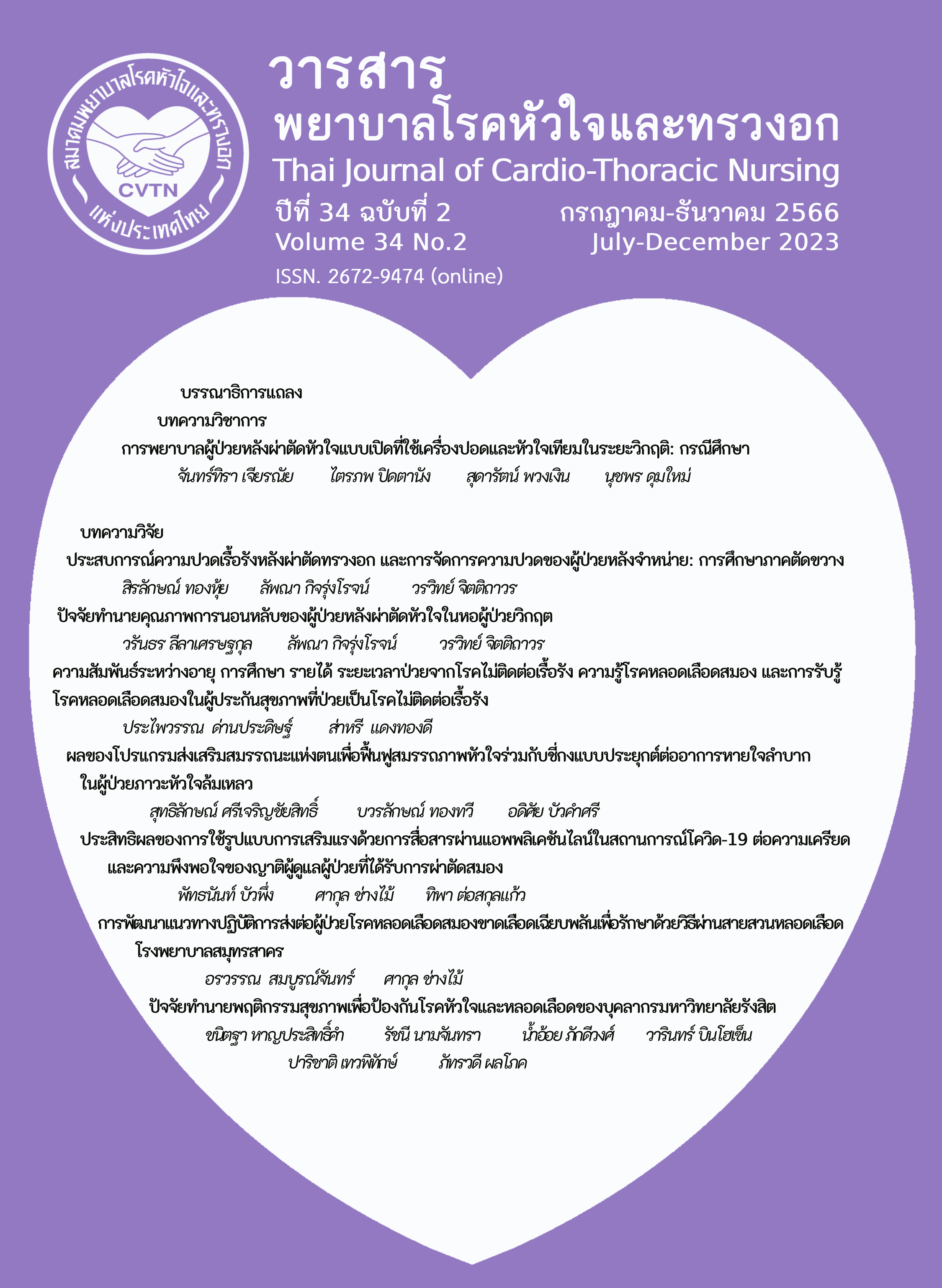ผลของโปรแกรมส่งเสริมสมรรถนะแห่งตนเพื่อฟื้นฟูสมรรถภาพหัวใจร่วมกับชี่กงแบบประยุกต์ต่ออาการหายใจลำบากในผู้ป่วย ภาวะหัวใจล้มเหลว
คำสำคัญ:
สมรรถนะแห่งตน, ชี่กงแบบประยุกต์, อาการหายใจลำบาก, ภาวะหัวใจล้มเหลวบทคัดย่อ
การศึกษาครั้งนี้ เป็นการวิจัยกึ่งทดลองแบบสองกลุ่ม วัดผลก่อนและหลังการทดลอง มีวัตถุประสงค์เพื่อศึกษาผลของโปรแกรมส่งเสริมสมรรถนะแห่งตนเพื่อฟื้นฟูสมรรถภาพหัวใจ ร่วมกับชี่กงแบบประยุกต์ ต่ออาการหายใจลำบากในผู้ป่วยภาวะหัวใจล้มเหลว กลุ่มตัวอย่างเป็นผู้ป่วยที่ได้รับการวินิจฉัยว่าเป็นภาวะหัวใจล้มเหลวห้องซ้ายที่เข้ารับการรักษา ณ หอผู้ป่วยอายุรกรรม และ/หรือ หอผู้ป่วยวิกฤติโรคหัวใจ โรงพยาบาลตติยภูมิขั้นสูงแห่งหนึ่ง จำนวน 64 คน เลือกกลุ่มตัวอย่างแบบเฉพาะเจาะจงตามคุณสมบัติเกณฑ์ที่กำหนด เป็นกลุ่มควบคุมที่ได้รับการพยาบาลตามปกติ 32 คน และกลุ่มทดลอง ที่ได้รับโปรแกรมส่งเสริมสมรรถนะแห่งตนเพื่อฟื้นฟูสมรรถภาพหัวใจด้วยชี่กงแบบประยุกต์เป็นเวลา 10 สัปดาห์ กลุ่มละ 32 คน เครื่องมือที่ใช้ในการวิจัยประกอบด้วย แบบสอบถามข้อมูลส่วนบุคคล โปรแกรมการส่งเสริมสมรรถนะแห่งตนในการประยุกต์ใช้ชี่กงเพื่อฟื้นฟูสมรรถภาพหัวใจเป็นระยะเวลา 10 สัปดาห์ แบบประเมินอาการหายใจลำบาก แบบวัดการรับรู้สมรรถนะแห่งตนผู้ป่วยภาวะหัวใจล้มเหลว วิเคราะห์ข้อมูลโดยใช้สถิติเชิงพรรณนาและสถิติที (t-test)
ผลการศึกษาพบว่า ภายหลังการเข้าร่วมโปรแกรมส่งเสริมสมรรถนะแห่งตนเพื่อฟื้นฟูสมรรถภาพหัวใจด้วยชี่กงแบบประยุกต์ กลุ่มทดลองมีค่าเฉลี่ยคะแนนอาการหายใจลำบาก (Mean=1.84, SD=1.08) และต่ำกว่ากลุ่มควบคุม (Mean=23.28, SD=2.65) อย่างมีนัยสำคัญทางสถิติ (P<0.001)
ข้อเสนอแนะในการนำการวิจัยไปใช้ บุคลากรทางสุขภาพที่ดูแลผู้ป่วยภาวะหัวใจล้มเหลว อาจพิจารณานำโปรแกรมนี้ไปใช้ในการดูแลผู้ป่วยภาวะหัวใจล้มเหลวเพื่อให้อาการหายใจลำบากลดลงได้
เอกสารอ้างอิง
Tsao CW, Aday AW, Almaizooq ZI, Anderson CAM, Arora P, Avery CL, et al. Heart disease and Stroke statistics-2023 update: a report from the American Heart Association. Circulation. 2023; 147(8): e93-e621. doi: 10.1161/CIR.0000000000001123.
Chaimongkol O, Puwanant S, Phumivadhana S. Nurses's role in caring for patients with heart failure at ambulatory care. Vajira Nursing Journal. 2022; 24(1): 75-95. (in Thai).
Maharak C. Mortality rate and readmission rate of heart failure patients in Phang Nga Hospital. Region 11 Medical Journal. 2022; 33(2): 311-325. (in Thai).
Heart Failure Council of Thailand (HFCT) 2019 heart failure guideline. [homepage on the Internet]. 2019 [cited 2021 Jun 30]; Available from: http://www.thaiheart.org. (in Thai).
Haynes A, Henry P. In: Urden LD, Stacy KM, Lought M.E. Cardiovascular disorder. Critical care nursing: diagnosis and management. 9th Edition. Canada: Elsevier; 2022. p.298-368.
Yancy CW, Jessup M, Bozkurt B, Butler J, Casey Jr DE, Drazner MH, et al. 2013 ACCF/AHA guideline for the management of heart failure: executive summary: a report of the American College of Cardiology Foundation/American Heart Association Task Force on practice guidelines. 2013; 128(16): 1810-52.
Dubé BP, Agostoni P, Laveneziana P. Exertional dyspnea in chronic heart failure: the role of the lung and respiratory mechanical factors. Eur Respir Rev. 2016; 25(141): 317-332. doi: 10.1183/16000617.0048-2016.
Boonyarat A. Rehabilitation exercise in persons with stable heart failure. Rama Nurse Journal. 2018; 24(1): 13-24. (in Thai).
Al-Khatib SM, Gentile FF, Birtcher KK, Gidding AS, Bozkurt FB, Hlatky FMA, et al. ACC/AHA/HFSA Focused update of the 2013 ACCF/AHA guideline for the management of heart failure. 2016; 22(9): 659-69. doi: 10.1016/j.cardfail.2016.07.001. PMID: 27394189.
Bozkurt B, Fonarow GC, Goldberg LR, Guglin M, Josephson RA, Forman DE, et al. Cardiac rehabilitation for patients with heart failure: JACC Expert Panel. J Am Coll Cardiol. 2021; 77(11): 1454-69. doi: 10.1016/j.jacc.2021. 01.030. PMID: 33736829.
Pandey A, Parashar A, Kumbhani D, Agarwal S, Garg J, Kitzman D, et al. Exercise training in patients with heart failure and preserved ejection fraction: meta-analysis of randomized control trials. Circ Heart Fail. 2015; 8(1): 33-40. doi: 10.1161/CIRCHEARTFAILURE.114.001615.
Chen X, Savarese G, Cai Y, Ma L, Lunaborg C, Jiang W, et al. Tai Chi and Qigong Practices for Chronic Heart Failure: A Systematic Review and Meta-Analysis of Randomized Controlled Trials. Evid Based Complement Alternat Med. 2020; 2020 2034625. doi: 10.1155/2020/2034625. PMID: 33381195; PMCID: PMC7755480.
Peisen Y. Healthy by Qigong: easy Guang-Im-Ju-Jai-Gomg. 7th Edition. Bangkok: Best graphic press; 2012. (in Thai).
Jemrod P. Qigong for health care. Thai Red Cross Nursing Journal. 2017; 10(1): 44-54. (in Thai).
Bandura A. Self-efficacy: the exercise of control. New York: Freeman and Company; 1997.
Rajati F, Sadeghi M, Feizi A, Sharifirad G, Hasandokht T, Mostafavi F. Self-efficacy strategies to improve exercise in patients with heart failure: a systematic review. ARYA atheroscler. 2014; 10(6): 319-333.
Information Technology. Thammasat University Hospital Inpatient Statistics. 2019 [homepage on the Internet]. [cited 2019 May 15]. Available from: http://www.hospital.tu.ac.th/it-tuh/.
Klinmai S. The effect of promoting self-efficacy and outcome expectancy in qigong exercise program on functional capacity in heart failure patients. [Master Thesis of Nursing Science]. Bangkok: Chulalongkorn University; 2011. (in Thai).
Polit DF, Beck CT. Nursing Research: principle and methods. Philadelphia: Lippincott Williams, Wilkins; 2012.
Sarai A. Effect of an integrated program of discharge planning and symptom experience on dyspnea management ability and dyspnea status of patients with chronic obstructive pulmonary disease. Songkhla: Prince of Songkhla University; 2016. (in Thai).
Gift AG. Validation of a vertical visual analogue scale as a measure of clinical dyspnea. Rehabil Nurs.1989; 14(6): 323-5.
Thai Heart Association. Guideline cardiac rehabilitation. Bangkok: Thai Heart Association; 2010.
Naunjan A, Thongthawee B, Matchim Y, Saiphoklang N. The effect of perceived self-efficacy in respiratory muscle training with modified Qigong program on duration of weaning from mechanical ventilator in patients with respiratory failure. Thai Journal of Cardio-Thoracic Nursing. 2021; 32(1): 152-65. (in Thai).
Magalhaes AA, Oliveira L, Pereira MG, Menezes CB. Dose meditation alter brain responses to negative stimuli? A systematic review. Front Hum Neurosci.2018; 13(12): 1-16.
ดาวน์โหลด
เผยแพร่แล้ว
รูปแบบการอ้างอิง
ฉบับ
ประเภทบทความ
สัญญาอนุญาต
ลิขสิทธิ์ (c) 2024 วารสารพยาบาลโรคหัวใจและทรวงอก

อนุญาตภายใต้เงื่อนไข Creative Commons Attribution-NonCommercial-NoDerivatives 4.0 International License.
บทความนี้ยังไม่เคยตีพิมพ์หรืออยู่ในระหว่างส่งไปตีพิมพ์ในวารสารอื่น ๆ มาก่อน และกองบรรณาธิการขอสงวนสิทธิ์ในการตรวจทาน และแก้ไขต้นฉบับตามเกณฑ์ของวารสาร ในกรณีที่เรื่องของท่านได้ได้รับการตีพิมพ์ในวารสารฉบับนี้ถือว่าเป็น ลิขสิทธิ์ของวารสารพยาบาลโรคหัวใจและทรวงอก






